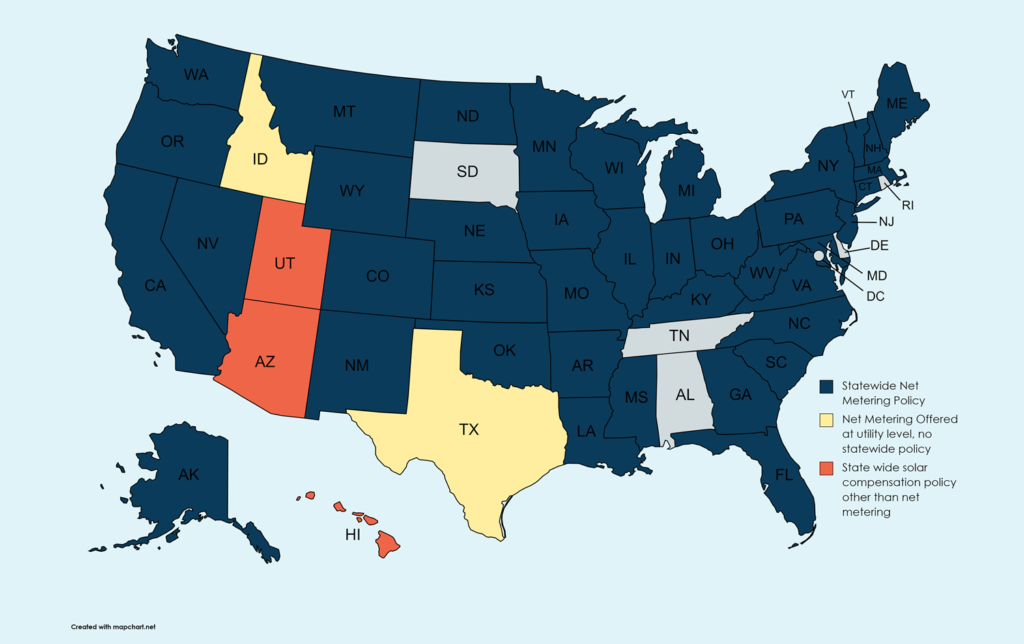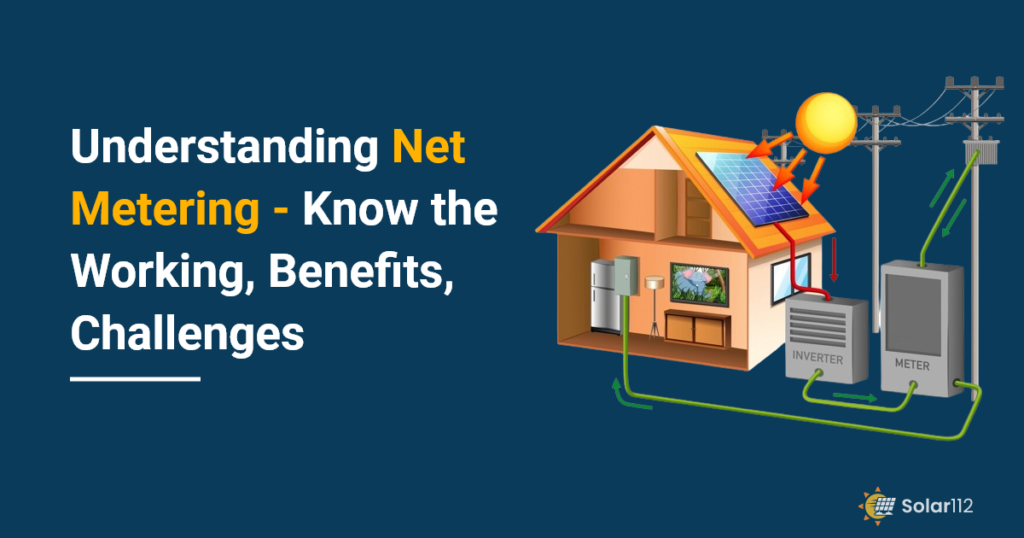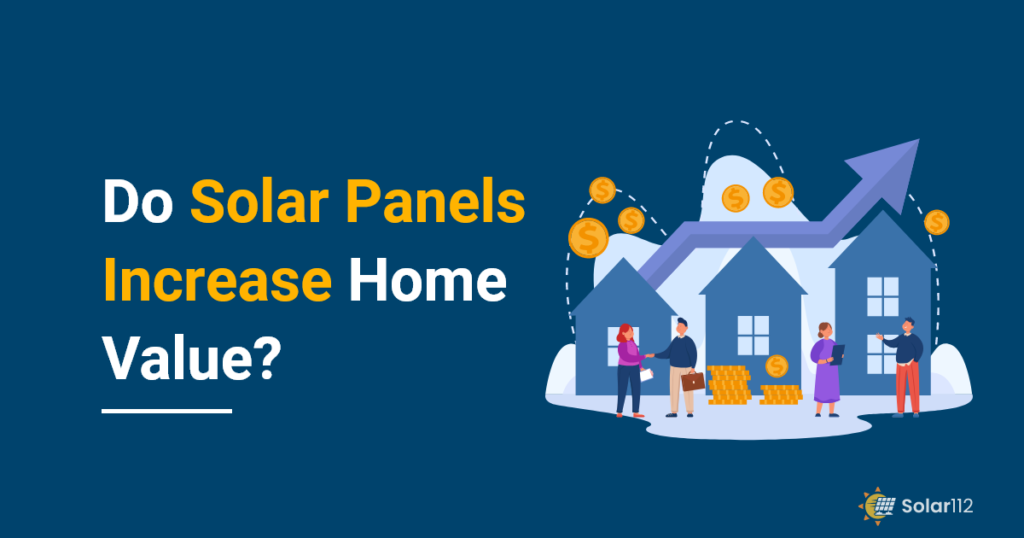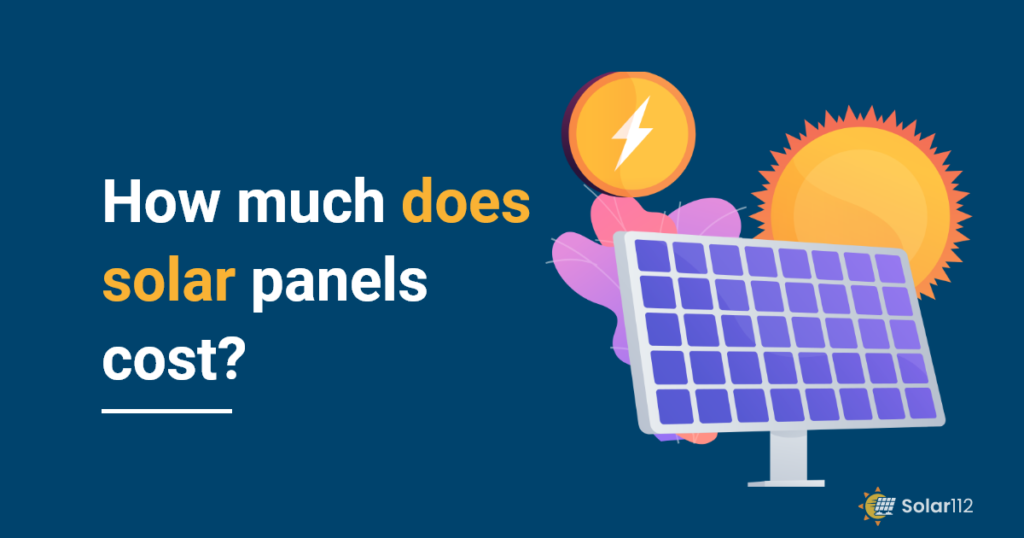Key Takeaways
- Net metering helps save on utility bills, relieves loads from utility providers, and contributes to reduced carbon emissions.
- The net metering programs vary based on three parameters: credit rollover, value of credits, and time of use.
- The common types of net metering include buy-all/sell-all energy, net billing, and virtual net metering (for those who can’t install panels on their property).
- Installing too many systems in a small region can complicate net metering.
- Net metering is not available in Alabama, South Dakota, or Tennessee.
Thanks to net metering, solar owners can generate additional income, and utility providers can get relief from peak electricity loads.
But what exactly is net metering? And more importantly, how does net metering work? How does it help homeowners to save more with solar panels? Are there any rules or regulations associated with it?
To answer such and more related questions, we have come up with this comprehensive blog. In this, we will share the ins and outs of solar net metering, including its workings, pros and cons, state-wide laws, and its long-term impact on homeowners, utility companies, and the environment.
So, without further ado, let’s get started!
What is net metering with solar panels?
In simple words, net metering is a billing mechanism in which solar owners are rewarded with credits in exchange for the additional electricity they add to the utility grid.
For instance, let’s say you have a grid-tied PV system installed on your rooftop. When your net-metered solar panel system produces extra energy on sunny days, the excess electricity is sent back to the grid. Or, on cloudy days or days when your energy consumption is higher than average production, you can pull the electricity back from the grid.
At the end of the month or year, you will be billed in the form of credits for the net amount of electricity you send to and pull back from the grid. That is why it is called net metering.
Usually, an average of 20 to 40% of electricity goes into the utility grid, which serves the households’ loads in that area.
In the United States, some states have been mandated by the net metering law for years. On the other hand, some states are taking their steps back from net metering due to its complicated economics of participation.
Let’s find out more about it in detail.
How does net-metering work?

The net metering that we explained above is also called true net metering or one-for-one net metering. The reason is that for every kwh of electricity your grid-tied system produces, your power bill reduces by 1 kwh. Or we can take it this way: in the case of excess energy generated by the system on sunny days, you can get 1 credit every time your system sends back 1 kwh of electricity back to the utility grid. And this credit can further be redeemed in the kWh on cloudy days. Hence one-to-one net metering.
Let’s understand the net metering bill with an example:
When you tie your solar panel system to the grid, your local power provider replaces your traditional electric meter with a new bi-directional meter. This records the total amount of solar energy your system exports to the grid as well as the total amount of solar energy you withdraw from the grid when the panels aren’t producing that much power.
The utility then finds the net energy sent to and consumed from the end at the end of each billing cycle. If your system has exported more energy than you have taken from the grid, then your solar credits will be added to the following monthly bill in the form of credits rollover. If you have used more, then your power provider will charge you for that difference.
However, it is imperative to understand that not all net metering programs function in the same manner. Based on the state you are living in, you can find variations based on the following parameters:
Credit rollover (monthly, annually, indefinitely)
In simple words, credit rollover means the remaining energy credits are passed over months over months, and customers can use these credits to purchase electricity when the days aren’t bright.
Some power companies let homeowners pass over these credits for a lifetime. However, many of them rectify the credits at the end of the year and reimburse them at a near wholesale price. The time period starts from the day the homeowner gets permission to operate with the connected utility grid. This whole process is called a true-up date.
Some companies even let solar owners decide their yearly true-up date, while in some cases companies themselves decide a date, which is often the late spring. There are also regions where these credits are rolled over on a monthly basis.
Value of credits
As discussed earlier, homeowners get rewarded in the form of KWH credits every time they export energy to the grid. However, some net metering programs reward in terms of flat-money credits, which are nearly the same or less than the retail value of 1 kwh of energy.
For instance, in Net Energy Metering (NEM) 3.0 in California, the value of monetary bill credits is less than the retail value of energy.
Time of use (TOU) rates
Time-of-use rates mean the price of electricity varies based on the time it is used. The TOU usually has two different rate plans: on-peak and off-peak.
Most utility companies charge under these plans. Thus, solar homeowners will get credit based on the time they export energy to the grid.
For instance, the electricity is on peak demand after 6 p.m. when people go back home after their office hours and start using the equipment. So, if you send back the energy during this time, you will get higher-value credits than in the morning when there is less energy demand.
Benefits of solar net metering
The concept of net metering came into existence to provide numerous benefits to homeowners, utility companies, and the environment. Below are they:
Give homeowners more control over their power bills
Net metering allows solar owners to control how much clean energy they want to generate and consume. And how much they want to export to the grid and earn the credits. Either way, by using net metering, homeowners can control how much they want to save on their electricity bills.
Eliminated the need for solar batteries
Contrary to off-grid solar panel systems, grid-tied systems do not require homeowners to invest in solar batteries. In the net-metered system, the excess electricity is directly stored in the utility grid. Hence, it eliminates the need for a battery storage solution. Also, the grid acts as a backup generator. This also saves you from investing in sky-high generators.
Reduces carbon footprint
Net metering makes going solar more affordable and viable for the residents. This encourages them to install PV systems on their property and produce more electricity from renewable and clean sources of energy rather than fossil fuels. This benefits the environment in two ways: one, it reduces the depletion of fossil fuels, and two, it mitigates carbon footprints. Hence, net working indirectly contributes to planet sustainability.
Take the load off from the utility grid
The net metering programs have proven to be a great relief for utility companies too. During the peak seasons, when the electricity demand is too high, the net energy metering spurs the tenants to produce power close to their home needs. This takes off the burden of the grid in transmitting and distributing electricity, especially over long distances.
Make solar feasible, even for tenants
Through the virtual net energy metering arrangement, even tenants or residents who don’t own homes in the U.S. can avail themselves of the benefits of solar.
Contributes to the nation’s economy
The net metering program increases the desire for solar energy among homeowners. This results in an increasing demand for high-quality manufacturers and jobs for solar panel installers and electricians. All this significantly contributes to the American economy. As of 2023, more than 2.3 lacs Americans are employed in the solar industry, solely because of net metering practices.
Is net metering bad?
Well, using the term bad won’t be right; however, drawbacks would be. Let’s have a look at them:
The net metering program works wonderfully when there are fewer grid-tied systems that are interconnected. However, in the case of too many installations, the grid demand started to decrease during the day but did not raise problems during dusk.
With too many installations in a compact region, the need to maintain the distributed grid systems also rises. That ends up leaving ratepayers with eventually higher electricity costs.
It’s a controversial statement, but some utility providers have witnessed a cost shift from richer to poorer. Over the last decades, the utility companies have used the cost shift in order to end the net metering program. But then, no one knows the whole story.
The other types of net metering
While it’s true that traditional net metering offers some robust benefits to homeowners, there are nice alternatives to that. All these have good success rates and are getting popular across many streets in America. Let’s have a look at them:
But all/sell all
Contrary to conventional net metering programs, under the buy-all-sell-all model, the homeowner sells the complete solar energy produced by their system to the utility providers. And in exchange for that, they receive 100% of the electricity at the retail rate.
Under this policy, two separate electricity meters are deployed that record the energy exported by the system and the energy consumed by the customer. At the end of the billing cycle, you will pay the net difference. Also, you can’t simply utilize the energy produced by your PV system. It has to go through the grid system.
Net billing
Net billing has been successfully working in large-scale commercial areas. However, with the growing popularity of distributed solar residential systems, they are being implemented in home installations too.
It is very similar to net metering. Under this, you also use the system as a source for storing the additional energy produced by your system. However, the difference lies in the compensation rate. In net billing, in spite of cashing the credits, you sell all your credits at a wholesale price instead of retail (unlike the one in net metering).
Virtual Net Metering (VNM)
Most states in the United States, including Colorado, Connecticut, Hawaii, New York, Maryland, and more, are taking advantage of virtual net metering programs. Some of them have even enabled VNM5. Under virtual net metering, homeowners that can’t afford or finance the solar panels installed on their property can also take advantage of net metering.
You must first become an eligible member by subscribing to the local community farm. Following that, when the solar farm produces and exports sufficient energy to the grid, the resultant net meeting credits will be distributed among its subscribers at a discounted price. And this way, you will be able to save 10–20% on your yearly power bills.
Net metering availability by state

The net metering programs have not been implemented across the entire United States yet. In some states, there is no net metering, and storing excess energy generated by the system in solar batteries is the only viable option. In other states like Arizona, net billing programs are ruling the residential market.
While in others, some standard net metering rules are required by law and often compensated with credits nearly equal to the retail value of electricity. Examples of such states are Oregano, Wyoming, New Mexico, Illinois, and more. Therefore, depending on the location you are currently living in, you can avail of the benefits of net metering.
Final Words: Why is net metering in solar energy important?
Net metering programs are one of the most encouraging factors for homeowners to install solar panel systems on their property. Because of it, the solar owners can generate their own electricity and take full command over their power bills. Also, they contribute towards combating the global climate crisis.
In the meantime, the utility companies can buy the excess energy from the solar owners and also efficiently manage their peak electricity load. With more advanced and decarbonized distributed grid-tied solar systems, their importance and demand in the future are only going to increase.
Having said that, we hope that you now know everything about net metering and how it works.
In case of further doubts, feel free to ask in the comments section below. We would be glad to help you.



